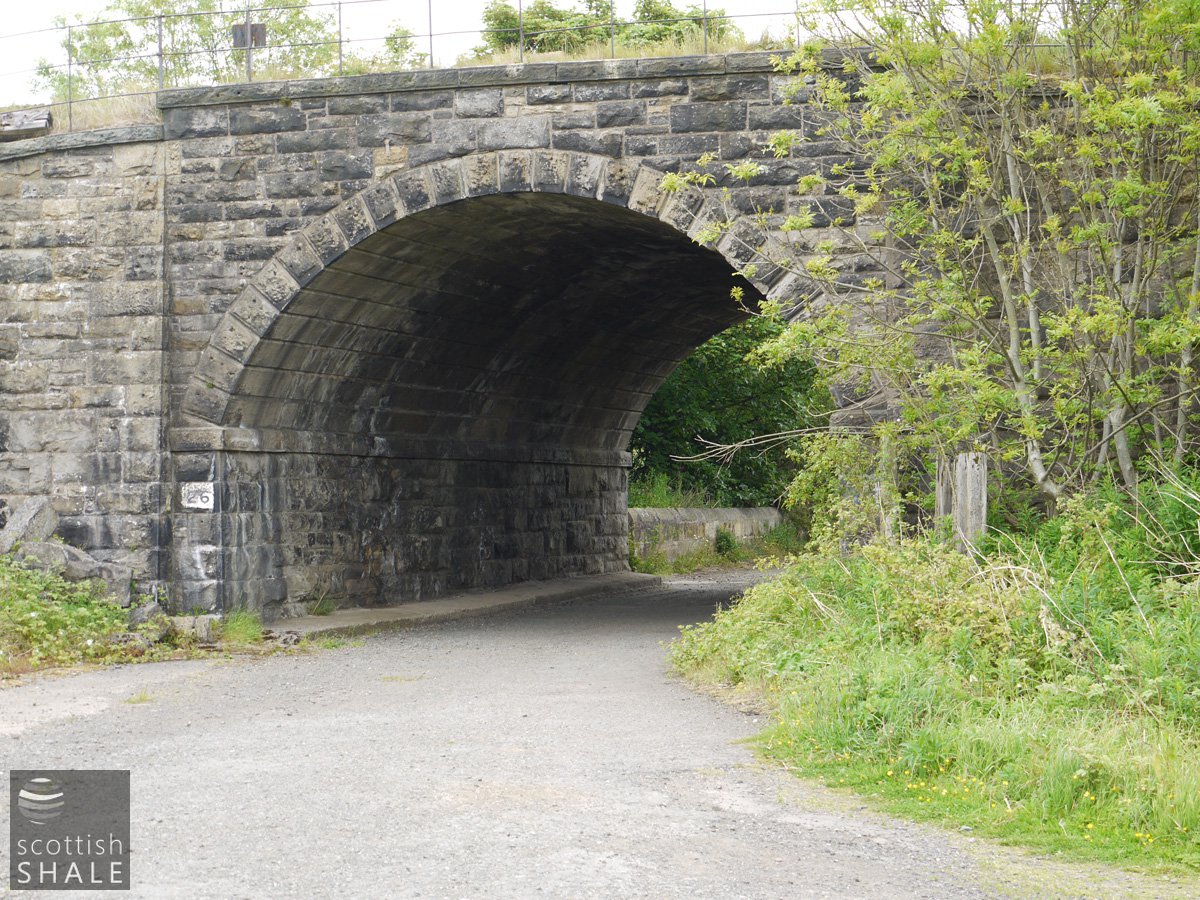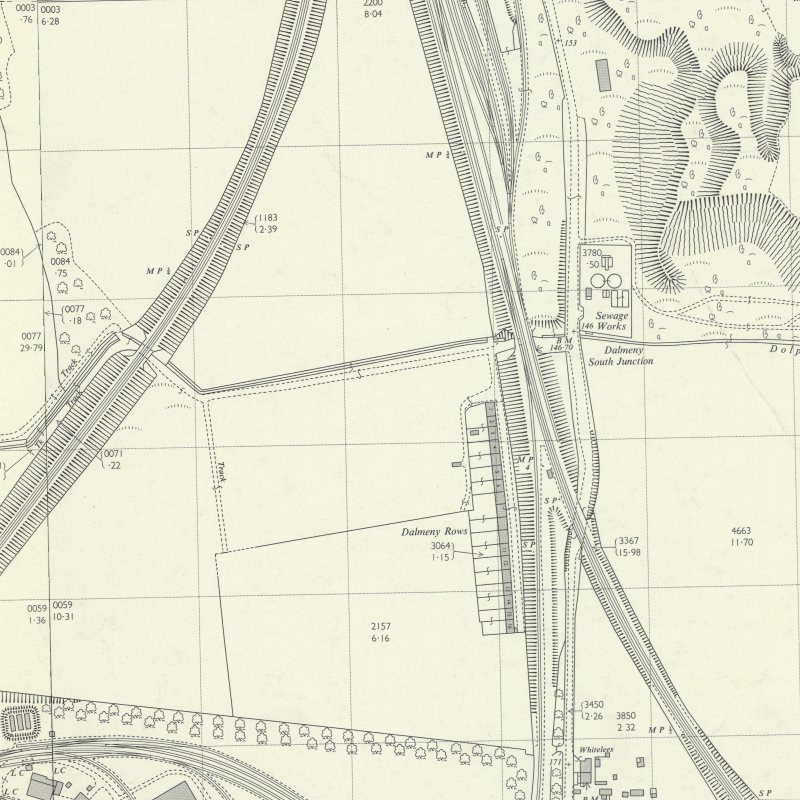- Addiewell village
- Addiewell - Muirhall villas
- Albyn Cottages
- Binnend village
- Bridgend Rows
- Broxburn Rows
- Broxburn - Steele's Rows
- Broxburn - villas
- Burngrange Cottages
- Burnside Cottages
- Cobbinshaw North village
- Cobbinshaw South village
- Dalmeny Rows
- Deans Cottages
- Dedridge Cottages
- East Hermand (village)
- Forkneuk Road, Uphall
- Gavieside village
- Gerson Park
- Greendykes Cottages
- Happy Land
- Hartwood Row
- Hermand New Rows
- Hermand Old Rows
- Holmes Cottages
- Holmes Rows
- Holygate
- Kingscavil Rows
- Kipsyke huts
- Livingston Station village
- Loaninghill Coattages
- Lochend cottages
- Straiton - Meadow Bank cottages
- Mid Breich Rows
- Midcalder - Penny's Buildings
- Middleton Hall - housing
- Mossend village
- Murchison Buildings
- New Holygate
- Newton Cottages
- Niddry Rows
- Oakbank village
- Oakbank Cottages, Westwood
- Redcraig cottages - Oakbank
- Straiton - Pentland Rows
- Philpstoun - The Avenue
- Philpstoun - Wester Pardovan Rows
- Pumpherston - Erskine Place
- Pumpherston - North Village
- Pumpherston - Pumpherston Road
- Pumpherston - South Village
- Pumpherston - Uphall Station Road
- Raeburn Rows
- Redhouse Cottages
- Roman Camp village
- Rosebery Cottages
- Seafield Rows
- Stable Rows
- Starlaw Rows
- Stewartfield Rows
- Straiton - Oakbank Cottages
- Tarbrax (village)
- Uphall Station Rows
- Uphall Station - Beechwood
- Uphall Station - Office Rows
- Uphall Station - Stankard Rows
- West Calder - Union Street & "Dalveen"
- Westerton Rows
- Westfield Rows
- Westwood (old rows)
- Winchburgh village
- Woolfords (new rows)
- Woolfords (old rows)
Dalmeny Rows
Built to serve Dalmeny Oil Works, construction of which began in 1870. The prospectus for the Dalmeny Oil Company, issued in September 1872, states "there are also a number of excellent workman's houses, and a manager's house, belonging to the works."
Conditions were described in evidence presented to the Royal Commission on housing conditions in 1914:
"At Dalmeny there are 51 houses of two apartments, with scullery. Coal cellars and dry closets are provided for each tenant, but no wash-houses. Gravitation water is supplied by a few stand-pipes. Drying space is provided. Refuse is removed daily by the company. The rental for these houses is 3/6 week; inclusive of rates. There are also 21 single apartment houses, with similar conditions to above, rental 1/9 per week. Ashed pathways exist, and consequently, in wet weather are in a very dirty condition. The appearance of the rows are anything but inviting as a place of habitation for the population of 434 persons."
The 1897 OS map shows one row of 20 single room homes and one row of 6 single room homes, Also two rows, each with about 16 homes, probably with two rooms, and a long row of 18 two-room homes with their own gardens, running south to north. This long row survived to be marked on 1960's OS maps.
Rosshill Terrace, two rows of two storey brick built homes that survive close to Dalmeny railway station (55.986529, -3.380510) , have been described by some as "oil worker's houses". It seems likely that this was not the case, and that they were built by the Forth Bridge Company c.1890 to house their workforce.
Archive images

David Halkett (1880-1920) with youngest children Tom (born 1905) and Alice (born 1912) at the back door of their home.

David Halkett, his wife Alice (1879-1961, nee Davis,) and daughter Alice, with rake of wagons in the background.

Eldest child Jim Halkett (born1903) with friend "Eckie" Forbes.
Recent images

Dalmeny rows, 5th June 2011

Dalmeny rows, 5th June 2011

Dalmeny rows, 5th June 2011

Dalmeny rows, 5th June 2011
"At Dalmeny there are 51 houses of two apartments, with scullery. Coal cellars and dry closets are provided for each tenant, but no wash-houses. Gravitation water is supplied by a few stand-pipes. Drying space is provided. Refuse is removed daily by the company. The rental for these houses is 3/6 week; inclusive of rates. There are also 21 single apartment houses, with similar conditions to above, rental 1/9 per week. Ashed pathways exist, and consequently, in wet weather are in a very dirty condition. The appearance of the rows are anything but inviting as a place of habitation for the population of 434 persons." Theodore K. Irvine, Report on the Housing Conditions in the Scottish Shale Field, 1914.
- Oral history transcript: Anonymous, Mrs L
- Oral history transcript: Anonymous, Mr & Mrs W
- Oral history transcript: Mr & Mrs Cameron
- Oral history transcript: Mr & Mrs Livingstone
- Oral history transcript: Mr & Mrs Paterson






